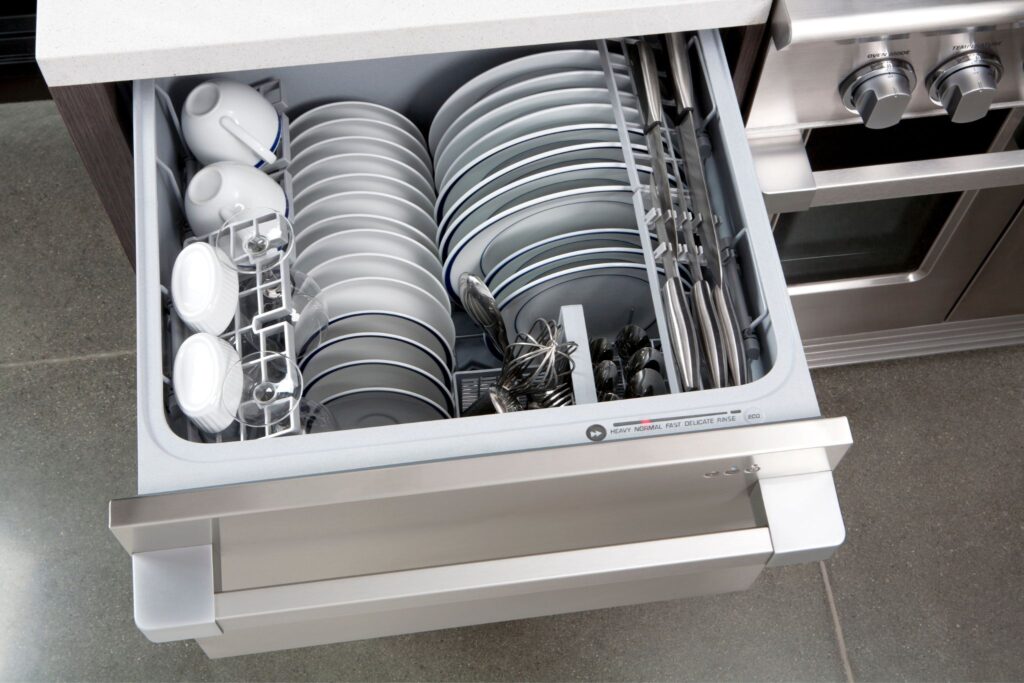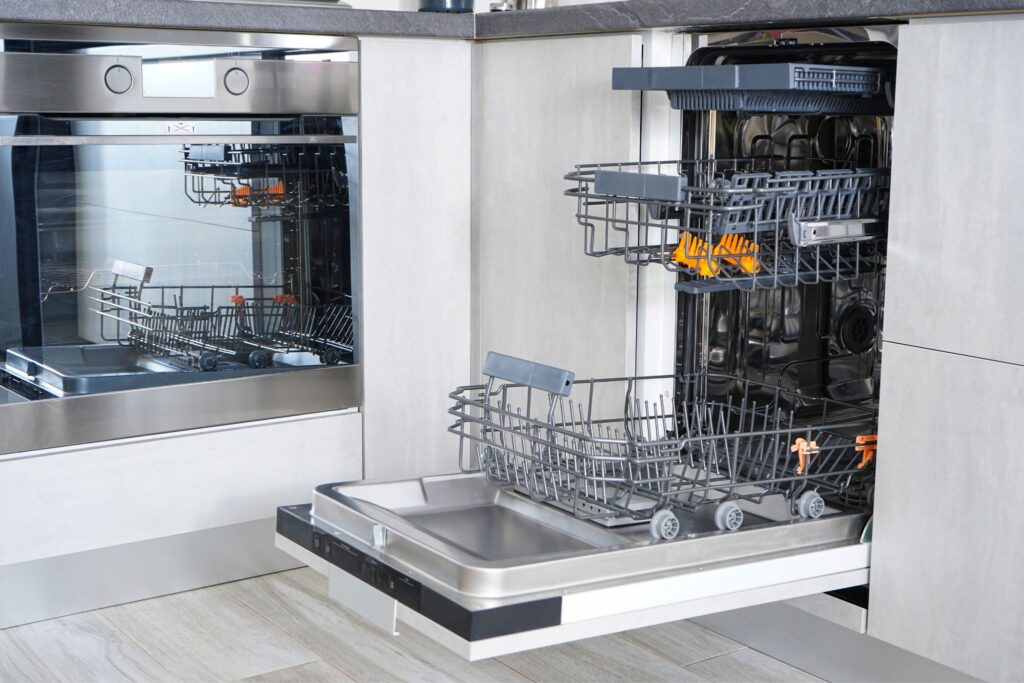Originally Created on: March 23, 2023 @ 9:30 am
What is difference between built in and counter top dishwashers? You may have wondered. Dishwashers are a common type of appliance used in homes because of their ability to save both time and effort in the kitchen.
There are various types of dishwashers available on the market, including built-in and countertop units, each having its own benefits and drawbacks.
Dishwashers that are designed to be permanently installed in a kitchen are referred to as built-in versions. These machines are larger and more powerful than those that are designed to sit on a countertop.
Dishwashers that are built into countertops, on the other hand, tend to be larger, less portable, and more expensive than their countertop counterparts.
Before making a purchase decision, it is essential to grasp the distinctions between these two types of dishwashers and their advantages and cons.
This article will examine the distinctions between built-in and countertop dishwashers and assist readers in determining which style of dishwasher best suits their needs.
You May Also Like: Why Isn’t My Dishwasher Spraying Water [3 EASY Fix]
Table of Content
What Is Difference Between Built In And Counter Top Dishwashers

Built-in dishwashers intended for permanent installation in a kitchen cabinet or beneath a countertop. They are often concealed from view when the cabinet door is closed because they are designed to be incorporated into the overall layout of the kitchen.
Dishwashers built into cabinets are often larger than those found on countertops and have the capacity to clean more utensils at once.
Countertop dishwashers, on the other hand, are designed to sit on countertops or other flat surfaces.
Due to the fact that they are more portable and much more compact than built-in dishwashers, they are an excellent choice for those who live in apartments, have small kitchens, or simply do not have the space for a built-in dishwasher.
Also, they are often more affordable than dishwashers that are incorporated into kitchen cabinets. The primary distinctions between built-in and countertop dishwashers, in general, are how they are installed, the amount of space they require, and the cost.
Dishwashers that are built into kitchen cabinets are more expensive, take up more space, and must be installed permanently. Countertop dishwashers, on the other hand, are more compact, more mobile, and cost less overall.
Another major distinction between built-in as well as countertop dishwashers is that built-in dishwashers are permanently installed in a kitchen cabinet or under a countertop, whereas countertop dishwashers sit on top of a countertop or other flat surface.
Dishwashers that are built into kitchen cabinets are often larger, can store more dishes, and cost significantly more than countertop dishwashers, which are typically smaller, more portable, and cost significantly less.
Your specific requirements and the amount of space you have in your kitchen should guide your decision between the two distinct types of dishwashers.
Countertop vs Built In Dishwasher

When deciding between a built-in dishwasher and a countertop dishwasher, it is crucial to take into consideration the size of your kitchen, your available budget, and the way you typically use your dishwasher.
Dishwashers that fit on top of the counter are convenient options for people who have limited room in their kitchens, such as those who live in apartments. They are also less expensive than built-in models, making them an attractive choice for anyone who is working with a limited budget.
Dishwashers that sit on a countertop are designed to be portable and simple to relocate, making them an appealing option for people who are always on the go or who wish to use their appliances in a variety of settings.
On the other hand, countertop models are typically smaller and less powerful than built-in versions of the same appliance.
Because they are permanently installed in the kitchen, they are a better option for individuals who have more room and want a solution that is there to stay. As a result of their increased capacity and improved energy efficiency, built-in dishwashers are ideally suited for households with a greater number of members.
Whether you go with a built-in or a countertop dishwasher ultimately comes down to personal preference and available space.
Can A Countertop Dishwasher Be Built In?

Although it is technically possible, installing a countertop dishwasher in the same manner as a built-in dishwasher is not something that is encouraged.
Dishwashers that are meant to sit on top of a countertop or another flat surface are referred to as countertop dishwashers. It is possible that these dishwashers will not fit correctly or perform effectively if they are placed as built-in appliances.
In addition, built-in dishwashers need certain plumbing and electrical connections, which a countertop dishwasher often does not have. These connections may not be compatible with a countertop dishwasher.
If you try to install a countertop dishwasher in the same manner as a built-in appliance, you run the risk of nullifying the guarantee offered by the manufacturer and creating a potential safety danger for yourself.
If you are thinking about installing a dishwasher in your kitchen and have room for a built-in model, it is typically recommended that you select a dishwasher that is designed specifically for built-in installation.
This will ensure that the installation goes as smoothly as possible. This will guarantee that the dishwasher will fit correctly and will run in a secure and effective manner.
Can Any Dishwasher Be Built In?
Not every dishwasher can be integrated. Only dishwashers that have been developed and constructed from the ground up to be placed as built-in appliances are eligible for installation in a home.
These dishwashers have precise dimensions and features that are required for optimal installation, as they were designed to be integrated into the cabinetry or to be placed underneath the countertop.
Built-in dishwashers often have a front panel that is intended to be concealed behind a cabinet door.
Moreover, built-in dishwashers frequently have legs that are movable, which enables them to be leveled with the cabinetry that surrounds them.
In addition to this, the electrical and plumbing connections that are necessary for installing one are not the same as those needed for installing a countertop or portable dishwasher.
It is imperative that you select a dishwasher that is made expressly for built-in installation if you intend to install a dishwasher that is designed to be built into a cabinet or other structure in your kitchen.
This will verify that the dishwasher is installed correctly, that it runs in a safe and efficient manner, and that it satisfies all of the relevant criteria regarding the electrical and plumbing systems.
Conclusion
it is important to note that there are several varieties of dishwashers, such as both built-in and countertop ones.
As its name suggests, built-in dishwashers are intended for permanent installation in the kitchen and hence necessitate unique plumbing and electrical hookups. They differ from countertop dishwashers in being bulkier, more powerful, and more expensive.
Dishwashers for the countertop, on the other hand, are smaller and cheaper than their built-in counterparts and can be moved from place to place. When you’re short on cash or counter space, they’re a smart choice.
It’s crucial to remember that not all dishwashers are designed to be placed as built-in appliances and that converting a freestanding dishwasher into a built-in one could be dangerous.
A dishwasher not made for built-in installation will not fit properly, so be sure to research your options before making a purchase. Yet, a countertop dishwasher may be more practical if you’re short on counter space or cash.
Your final decision between a built-in and a countertop dishwasher should be guided by your specific requirements, available counter space, and financial constraints.

